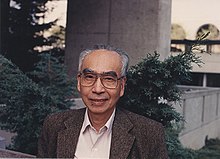Tosio Kato
Tosio Kato ( Japanese 加藤 敏夫 , Katō Toshio ; born August 25, 1917 in Kanuma ; † October 2, 1999 in Oakland , California) was a Japanese mathematician who dealt with partial differential equations , mathematical physics and functional analysis .
Life
Kato studied physics and made his intermediate diploma in 1941 at the University of Tokyo . After interruptions by the Second World War, he received his doctorate in 1951 at the University of Tokyo, where he became a professor in 1958. From 1962 he was active as a professor at the University of California, Berkeley .
Much of Kato's work is related to mathematical physics. In 1951 he showed the self adjointness of the Hamilton operators in quantum mechanics for realistic (singular) potentials. He dealt with nonlinear evolution equations, the Korteweg-de-Vries equation ( Kato smoothing effect 1983) and with solutions to the Navier-Stokes equations . In the case of the Navier-Stokes equations in three dimensions, one of the open problems is the question of the existence of regular, unique solutions ( solved in two dimensions by Jean Leray ), one of the Millennium problems . Kato pursued a new approach via semigroups and scaling arguments due to the fractal nature of the solutions and proved the global existence of unique regular solutions in three dimensions, if the initial data are not "too large". Kato is also known for his influential book Perturbation theory of linear operators , published by Springer-Verlag.
The Kato problem, which he posed in 1953, is named after him. It asks whether the roots of certain elliptic operators ( defined in the functional calculus ) are analytic. The problem was solved in 2002 by Pascal Auscher , Steve Hofmann , Michael T. Lacey , Alan McIntosh and Philippe Tchamitchian .
In 1960 he received the Asahi Prize . In 1980 he won the Norbert Wiener Prize in Applied Mathematics from the Society for Industrial and Applied Mathematics (SIAM). In 1970 he gave a plenary lecture at the International Congress of Mathematicians (ICM) in Nice (Scattering theory and perturbation of continuous spectra).
Fonts
- Perturbation theory of linear operators. Basic teachings of the mathematical sciences, Springer-Verlag 1966, 1976.
- A short introduction to the perturbation theory of linear operators. Springer-Verlag 1982.
- Quasi-linear equations of evolution, with applications to partial differential equations , in: Spectral theory and differential equations (Proc. Sympos., Dundee, 1974; dedicated to Konrad Jörgens ), Springer, Berlin, 1975, Lecture Notes in Math., Vol 448, pp. 25-70
Web links
- John J. O'Connor, Edmund F. Robertson : Tosio Kato. In: MacTutor History of Mathematics archive .
- Obituary in the AMS Notices June / July 2000
Individual evidence
- ↑ Kato Strong solutions of the Navier-Stokes equations in with applications to weak solutions , Math. Z. 187, 1984, 471-480
- ↑ Marco Cannone, Susan Friedlander Navier: Blow up and Collapse , Notices AMS, January 2003
- ↑ Kato, Integration of the equation of evolution in Banach space, J. Math. Soc. Japan, Vol. 5, 1953, pp. 208-234
- ^ P. Auscher, S. Hofmann, M. Lacey, A. McIntosh, P. Tchamitchian: The solution of the Kato square root problem for second order elliptic operators on , Annals of Mathematics, Volume 156, 2002, pp. 633-654
| personal data | |
|---|---|
| SURNAME | Kato, Tosio |
| ALTERNATIVE NAMES | 加藤 敏夫 (Japanese); Katō Toshio; Kato Toshio |
| BRIEF DESCRIPTION | Japanese mathematician |
| DATE OF BIRTH | August 25, 1917 |
| PLACE OF BIRTH | Kanuma |
| DATE OF DEATH | October 2, 1999 |
| Place of death | Oakland |



